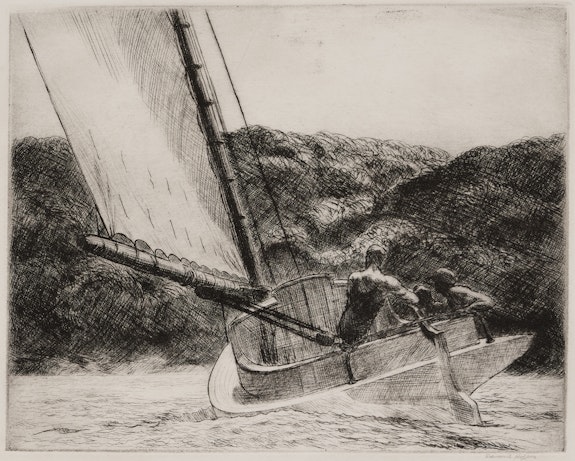ArtSeen
Edward Hopper as Puritan

On View
Craig Starr GalleryOctober 26–February 17, 2024
New York
More than half of the works included in Edward Hopper as Puritan date from the first half of the 1920s, specifically the years 1922–24, a momentous period during which the artist began spending summers on Cape Cod, met and married his wife Josephine (Jo) Nivison, temporarily gave up etching to focus on watercolor, and had his first museum acquisition. Included in the show are three etchings and a drawing of maritime scenes, and three watercolors and a drawing of coastal vernacular homes. At the center of the exhibition, serving as a kind of coda, is the enigmatic 1945 oil Two Puritans. Though the selection is modest and the works understated, they effectively illuminate Hopper’s personality and aesthetic.
Tying the exhibition together is an ambitious catalogue essay by British art historian Louis Shadwick (currently at work on a new biography of Hopper) that explores the discourse around the Puritan aesthetic, attached to the artist early in his career. The notion of Puritanism was contested throughout the first half of the twentieth century, alternately celebrated as a uniquely American cultural tradition or maligned as an outmoded and restrictive style. In an argument that proceeds from a 2021 article by Hopper scholar Gail Levin on this topic1, Shadwick emphasizes the racial connotation of Puritanism as it was understood by critics in Hopper’s era and how it was marshaled toward a nationalistic cultural agenda during the interwar years. Though he fashioned himself a “latter-day Puritan,” and signaled approval of critics who identified him as such, Hopper’s own remarks on the subject imply that he related more to the subjective qualities of Puritanism—earnestness and asceticism, for example, as well as a sense of cultural belatedness—rather than its racial undertones. While it is a provocative and timely argument, Shadwick’s essay sheds more light on the artist’s critical reception than it does the exhibited works themselves, with which it makes only fleeting contact. We must await his forthcoming Hopper biography to see how he fits this line of argumentation into the broader context of the artist’s legacy.

Returning to the show, we find a variety of techniques and degrees of finish both within and among the watercolors, though all three focus on houses nestled on hills with walls shrouded in shadow. The earliest, Group of Houses (1923 or 1924) is the most loosely rendered, with broad washes in the foreground and foliage suggested by flickered marks. The exterior wall closest to us is more detailed, but not by much, and the homes next to it appear more as shapes than structures. Most captivating is a shadow, just below the center of the composition, painted in an opaque deep green. Like his later paintings of figures facing the sun, the dull, pale pink facade of the colonial revival home in Houses on a Hill (1926 or 1928) gazes sunward, pictured in three-quarter view, its ornate features captured by Hopper’s careful attention to them. The asymmetrical composition is counterbalanced between the home’s sun bleached warmth and the coolly shadowed house next to it.
The 1932 Kelly Jenness House is the quietest of the three, alone and distant from the viewer, sitting at the end of a short path from the nearby dirt road. An indistinct arc of green swoops across the ground directly in front of the home like a gust of wind. That passage, together with the broadly brushed foreground, wrap around the house like waves. The fluidity of the scene feels even more pronounced than that of The Cat Boat (1922), one of the maritime etchings. In contrast to the economically painted watercolors, the three etchings in general, and The Cat Boat in particular, with its thicket of crosshatching spanning the background, are rendered more robustly. Hopper’s line is confident and declarative, and he is unencumbered by the limitations of the medium, depicting a dramatic play of highlights and shadows on the windblown sails of The Henry Ford (1923), and suggesting inward emotion among the figures in Aux Fortifications (1923) seemingly by their posture alone.

As what Shadwick identifies as “a double portrait of Edward and Jo,” Two Puritans (1945) shows the two figures guarded and taciturn. The two homes sit behind a fence, the smaller one further fortified by a row of trees, the larger one featuring a front door without a handle, the windows of both homes showing nothing within, only darkness. Chilliness issues from the sickly, pallid green tint of the sky and tree trunks, with only a hint of warmth suggested on the smaller house by its chimney and the deep red gabled roof portico. In his catalogue essay, Shadwick characterizes the painting as a representation of Hopper’s “unyielding moral stance, standing firm as the last strongholds of earlier … cultural values.” Such is the condition of so many late career artists, like Monet or Beethoven or Olitski, who, working against the passage of time, synthesize and consolidate their style. Hopper’s impassiveness and austerity never feels ungenerous, and if he became conservative and his art reactionary, it was to his and our benefit, as the postwar years saw Hopper bring his painting toward a refinement and expansiveness not foretold by the quietude of his earlier Puritanism.
- Gail Levin, “‘Anglo-Saxon’: Nationalism and Race in the Promotion of Edward Hopper,” Panorama: Journal of the Association of Historians of American Art 7, no. 1 (Spring 2021).

